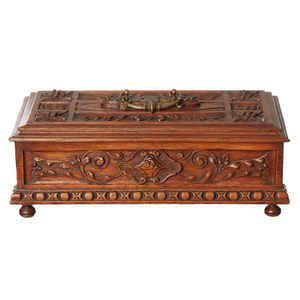Regency Tea Caddy with Marquetry and Brass Fittings
You must be a subscriber, and be logged in to view price and dealer details.
Subscribe Now to view actual auction price for this item
When you subscribe, you have the option of setting the currency in which to display prices to $Au, $US, $NZ or Stg.
- Ebony - Ebony is a close grained timber, black in colour. It has a fine texture which can be polished to a high gloss, making it suitable for venereering, inlay and stringing and its use as solid timber is resticted to small decorative items and ornamental decoration, such as chess pieces and musical instrument parts. The term "ebonised" means "faux ebony", timber that has been darkened during the polishing process to resemble ebony.
- Mahogany - Mahogany is a dense, close grained red-coloured timber from the West Indies and Central America. It was first imported into Europe in the the early 18th century and its use continued through the 19th century. It was popular for furniture making because of its strength, the wide boards available, the distinctive grain on some boards, termed flame mahogany and the rich warm colour of the timber when it was polished.. The "flame" was produced where a limb grew out from the trunk of the tree, and this timber was usually sliced into veneers for feature panels on doors, backs and cornices.
Some terms used to describe mahogany relate to the country from which it originally came, such as "Cuban" mahogany, "Honduras" mahogany etc. However unless the wood has been tested the names assigned are more a selling feature, rather than a true indication of the timber's origin. - Regency Period - The Regency period in English furniture design refers to the period when King George III, was declared unfit to rule in 1811, and his son ruled as proxy as Prince Regent, until 1820, and then, after the death of his father as George IV until his death in 1830. The Regency period was preceded by the Georgian period (George I, George II, and George III: 1714 - 1811), and was followed by the William IV period, which only lasted until 1837 when William IV died as was succeeded by Queen Victoria.
This item has been included into following indexes:
Visually similar items

A Regency rosewood brass inlaid tea caddy, circa 1830 with original mixing bowl, 18 x 35 x 18 cm

Robert Prenzel (1866-1941), a blackwood settle, circa 1904-1909 the rectangular back inscribed with the Latin motto Pax Huic Domui - Peace be to this house - above a gryphon frieze, stylised scroll arms and a hinged seat, the front and sides carved with wa

An Elizabethan style coffer, the fascia heavily carved with a panel depicting the Adoration of the Magi, between relief pilasters and panels, the hinged lid with moulded edge and some detail, the spreading base with rope edge, raised on large squat circula

An antique carved oak jewellery box in the Gothic manner, circa 1900. 16 cm high, 44.5 cm wide, 24 cm deep
